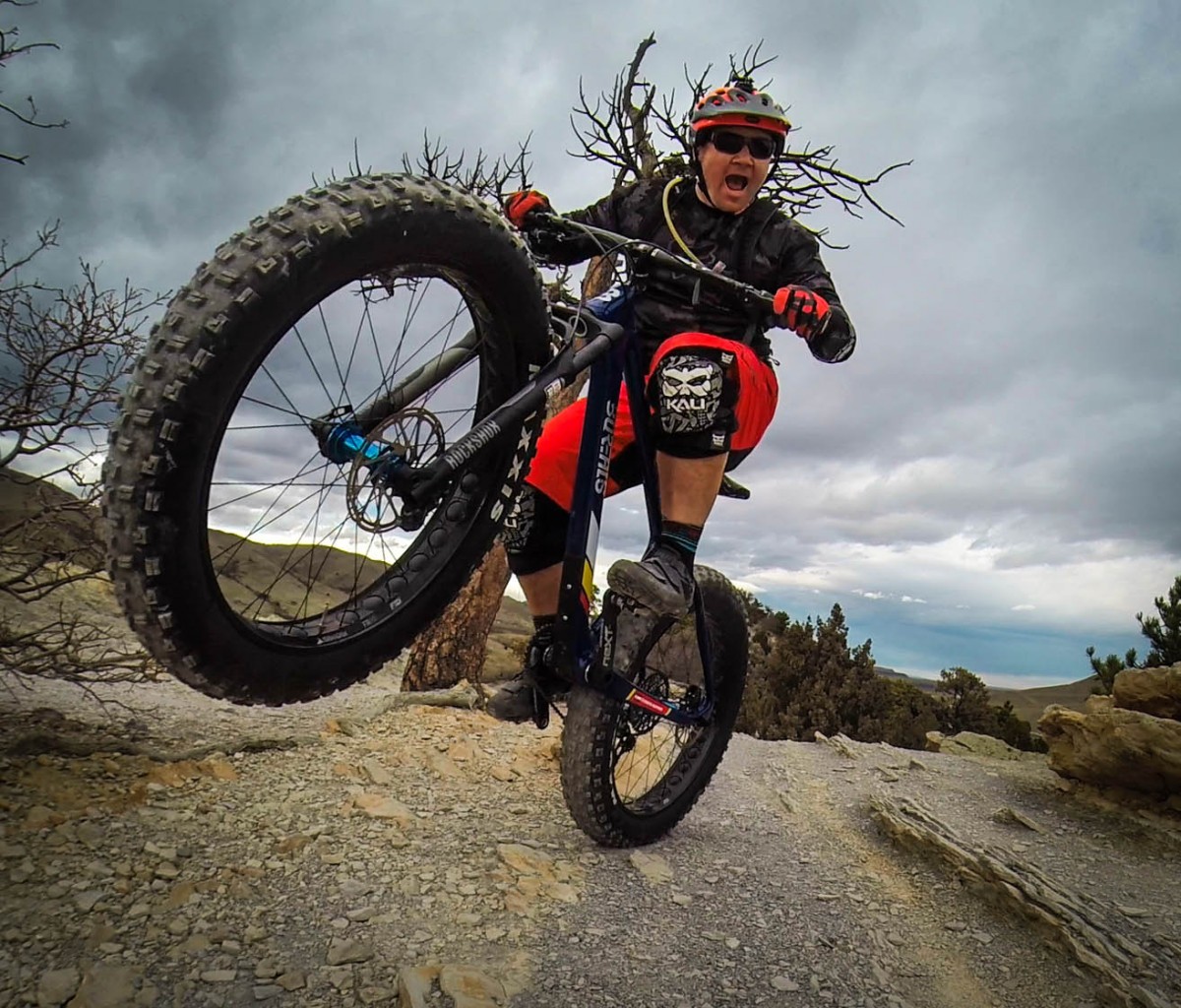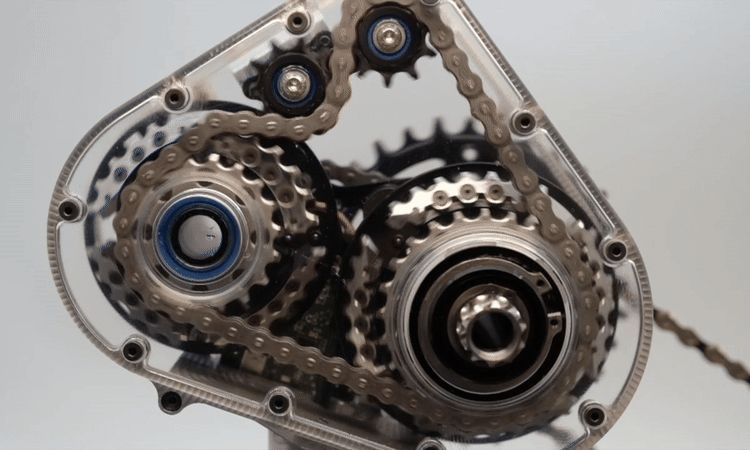Since my initial review of the Borealis Crestone, I’ve put a couple of hundred miles on it in both snowy and dry conditions. I tested this bike in deep powder, on packed trails, on flat trails, steep pitches, and on dry, technical terrain in the Colorado front range and in the Rocky Mountains.

The Build
The Frame
Borealis did a tremendous job engineering this frame. The geometry is a good mix, with preference towards XC racers, but slack enough to tackle technical features with confidence. The carbon is stiff, and the fit and finish of the internal routing ports looks great. The paint is beautiful, with thick, deep colors that make the curvaceous top tube and stays a functional work of art, damping all but the harshest trail vibrations.

Bluto 100mm RTC3 Fork
I’ve ridden the Bluto on my personal bike since testing one last year, and I am familiar with the pressures and how to set it up, which was a snap with this newer model as well. The latest version, found on the Crestone, comes with an improved damper and more adjustability for lockout, but honestly I just put my desired pressure in it and didn’t touch it for the duration of my test. It was a perfect addition to this bike, taking the sting out of fast, chunky descents, and was quiet with superb rebound and damping. Unlike the first generation model, the thru axle stayed in place and the fork was laterally stiff, handling every rock garden I plowed it through.
Guide Ultimate Brakes
This line of brakes have become my personal favorite since also testing the Guide RSCs last season. They have excellent modulation, easy reach adjustment, handy contact pad adjustment, and definitive four-piston stopping power. The new caliper design also uses a new seal design and piston interface, as well as lighter parts.

XX1 Drivetrain
Using a 1x drivetrain on a relatively heavy fat bike may garner a lot of criticism, but it actually makes a lot of sense. You sacrifice a very small range of gearing, but it fixes a lot of chainline issues and gives the rider the freedom to swap front chainrings with ease, depending on what type of riding you do. I absolutely loved the look and functionality of the gold KMC chain, and during the entire duration of testing the XX1 tranny was quiet, smooth, and literally flawless.

Next SL Crankset
Currently, this is the lightest production crankset on the market, and considered to be the crème de la crème by many. They have the unique benefit of working on any bike that RaceFace makes an axle to fit, so you could use these on a fatty or a regular mountain bike. I have this crank installed on my personal bike, and the only issue I’ve had is replacing the bearings more frequently than with other cranks in the past (my mechanic says this is because they are narrower and wear faster). I did not have any issues with the set on the Crestone, however, but time–and elements–will tell if these hold up under grimey duress.
I also had another mechanic tell me that some riders find the cranks to be a little flexy, but I’m a pretty big guy who throws down a lot of torque when I climb and have never found this to be the case. Nevertheless, they are really, really nice.
The RaceFace cinch system is also very easy to use as well, so riders can swap out different chainrings if they need a little extra help to get this fatty up a steep hill.

Wheels and Tires
The Crestone comes with house brand wheels mated to Maxxis Minion 4.8″ tires. The wheels are solid and not too heavy, and the hubs not only look amazing, they worked well without any issues even in below-zero conditions. I found the Maxxis Minions to be a great tire, but I have had better results with some other brands this season. The 4.8″ footprint is nice, but at 1620 grams, they are a relatively heavy shoe for the amount of traction they provided, particularly when paired with aluminum rims. I’ve been running 45NRTH Flowbeist/Dunderbeist on another bike this season, and although they are slightly narrower than the Minions, I feel that they have better grip on both snow and in dirt, using a stickier rubber compound and chunkier side knobs. I think a better all-around choice on the Crestone might be the Schwalbe Jumbo Jim 4.8″ Liteskins, particularly for groomed snow or buff trail conditions, saving about a pound of rotational weight. There is nothing specifically wrong with the Minions, but the weight penalty can be a chore on steep climbs in deeper powder. Borealis actually did offer to let me test a 29+ wheelset, but I honestly didn’t have time this season. I bet, however, it would open up a new way to ride the Crestone.

Cockpit
The fact that Borealis spec’d the Crestone with beefier 35mm bars really impressed me, and is one of the many small things I think make this bike really stand out. Borealis chose an Ergon saddle and grips, which appeal to the XC crowd, but may be uncomfortably hard for aggressive terrain. Because of this, I swapped out the saddle after a few rides for another one, which made a huge difference in ride comfort. I also felt that the Ergon grips were quite firm, especially in the cold weather, but elected to keep them on for the duration of testing, and they worked well. These are both personal items, but also expensive ones, so you may want to negotiate with your shop to swap them if they don’t work for you.

Ride Impressions
The weight of the bike (30 lbs), and more specifically, the 1620 gram Maxxis Minion 4.8″ tires mated to aluminum hoops, makes this bike a little sluggish when first moving out or when you step on the gas. 30lbs is a little portly for an XC-oriented fat bike when there are sub-20 lb offerings out there, but the Bluto and tires account for a lot of that weight, and serve a purpose. Once you get the bike moving, however, it keeps rolling fast, and feels like a monster truck when hauling downhill.

The Crestone comes standard with a 30T chainring, an overall good choice, and is probably fine for most riders, unless you live in a place like Colorado where steep climbs are mandatory. I found it tough to pedal uphill at times, particularly in the Rockies, and would have preferred a 26T or 28T to get up some of the hills. Racers may actually prefer a 32T or higher, depending on application. It’s hard to go fast with a 26T…

The bike felt on the larger size for a medium, and given the long top tube and reach, I personally would have preferred a shorter stem and wider bars. The bike comes standard with a 70mm stem and 750mm bars, which gives it a race-oriented feel, but it sacrifices a lot in terms of maneuverability. I swapped the 70mm stem for a 50mm one (and honestly would have used a 35mm stem if I owned one) and it improved handling considerably. I did not change the bars, and with a shorter stem, may not have elected to, but the long feel of the bike subtracted somewhat from the overall confidence the Crestone has on steep descents.

Nevertheless, the overall geometry on the Crestone is spot-on, and I had a blast testing it for what it was meant for: racing in snow. I also love the internal cable routing and the stiffness of the thru-axles, something missing on a lot of bikes these days, including the Crestone’s predecessor. The KMC chain is awesome, and adds some extra functional bling to the bike, which is always nice. I had no issues with creaking, the XX1 drivetrain was flawless even in some nasty conditions, and the Bluto was a welcome addition despite the 3lb weight penalty for this versatile race machine. The look of the bike really stands out, and the paint continues to impress me.
The main question is, how does it ride? In a word, sublime. Once I swapped the stem, post, and saddle to my liking, I had a lot of fun on this bike. The carbon is stiff but compliant and makes for a smooth ride, particularly with the flattened chainstays. It never felt flexy, or even too stiff when riding fast in rocky singletrack. The Crestone would get up to speed quickly despite those obese wheels if you stood up and laid down the power, without balking under pressure. The bike remained very quiet throughout the entire test period, which is not something I’ve ever experienced on any test bike, or my own for that matter.
The 18in chainstays are very reasonable for a 197mm rear end that handles a 5.0 tire, and getting the front end up to pop, manual, or wheelie didn’t take much effort. On Greg’s “Calf-Bang Factor,” I’d give it a 3/10, a great score. I only noticed calf bang when climbing steep pitches or riding out a wheelie–during flat, paced pedaling, I never felt it.
Because the geometry favors XC, the 70 degree head angle (and long stem) did hold me back from taking the Crestone off some jumps and drops I routinely do, even with my own fatty. It’s hard to say, but I would roll up to them and just didn’t feel like I could get the bike off of the ground and handle it in the air in a way that made me comfortable. Granted, it’s not designed to do a lot of that stuff, but I ride all of my bikes like that, even fully-rigid ones. Again, the frame felt on the larger side for a medium, which is great for racing. I think a very short stem (35mm) and some lighter tires may have given me the little extra that I needed to get the bike airborne more than I did, once again pointing to changes that revolve around personal preference and individual fit.
There is nothing I would change about the ride quality or the way that the Crestone handles, particularly if you are looking for a do-it-all fat bike that has XC roots but all-mountain capability. This bike may not be for the rider who likes to huck a fatty off a roof, but it is a very versatile race machine that can handle almost anything most riders can throw at it.
Borealis was an exceptional company to work with throughout this entire process, something I don’t always encounter when testing products… believe it or not. I love the fact that the company is based just an hour or so from where I live, too, and I will always fully support local, Colorado-based companies when I can. If you are in the market for a unique and well-rounded fatty, the Crestone XX1 should be on your short list.
MSRP: $6,050























0 Comments